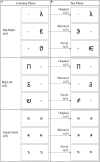Compatibility Between Physical Stimulus Size - Spatial Position and False Recognitions
- PMID: 30154752
- PMCID: PMC6102480
- DOI: 10.3389/fpsyg.2018.01457
Compatibility Between Physical Stimulus Size - Spatial Position and False Recognitions
Abstract
Magnitude processing is of great interest to researchers because it requires integration of quantity related information in memory regardless of whether the focus is numerical or non-numerical magnitudes. The previous work has suggested an interplay between pre-existing semantic information about number-space relationship in processes of encoding and recall. Investigation of the compatibility between physical stimulus size - spatial position and false recognition may provide valuable information about the cognitive representation of non-numerical magnitudes. Therefore, we applied a false memory procedure to a series of non-numerical stimulus pairs. Three versions of the pairs were used: big-right (a big character on the right/a small character on the left), big-left (a big character on the left/a small character on the right), and equal-sized (an equal sized character on each side). In the first phase, participants (N = 100) received 27 pairs, with nine pairs from each experimental condition. In the second phase, nine pairs from each of three stimulus categories were presented: (1) original pairs that were presented in the first phase, (2) mirrored pairs that were horizontally flipped versions of the pairs presented in the first phase, and (3) novel pairs that had not been presented before. The participants were instructed to press "YES" for the pairs that they remembered seeing before and to press "NO" for the pairs that they did not remember from the first phase. The results indicated that the participants made more false-alarm responses by responding "yes" to the pairs with the bigger one on the right. Moreover, they responded to the previously seen figures with the big one on the right faster compared to their distracting counterparts. The study provided evidence for the relationship between stimulus physical size and how they processed spatially by employing a false memory procedure. We offered a size-space compatibility account based on the congruency between the short- and long-term associations which produce local compatibilities. Accordingly, the compatible stimuli in the learning phase might be responsible for the interference, reflecting a possible short-term interference effect on congruency between the short- and long-term associations. Clearly, future research is required to test this speculative position.
Keywords: accuracy of recall; false memory; object size; reaction time; recall bias; signal detection; size–space compatibility.
Figures





References
LinkOut - more resources
Full Text Sources
Other Literature Sources

